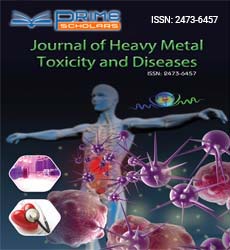Perspective - (2023) Volume 8, Issue 1
Evaluating the Impact of Antimony in Biological Element
Zhu Peng*
Department of Chemical Science, University of Peking, China
*Correspondence:
Zhu Peng,
Department of Chemical Science, University of Peking,
China,
Email:
Received: 02-Jan-2023, Manuscript No. IPJHMCT-23-15535;
Editor assigned: 04-Jan-2023, Pre QC No. IPJHMCT-23-15535 (PQ);
Reviewed: 17-Jan-2023, QC No. IPJHMCT-23-15535;
Revised: 23-Jan-2023, Manuscript No. IPJHMCT-23-15535 (Q);
Published:
30-Jan-2023, DOI: 10.21767/2473-6457.23.8.002
INTRODUCTION
The expansion being used of Nitro Aromatic Compounds (NACs),
toxic gases, heavy metal particles and poisons prompts different
issues in the climate. Metals are generally circulated in various
topographical districts by means of fluctuating fixation. A portion
of these metals are great for development and wellbeing, while
others incorporate weighty metals can lead to difficult issues in
all living species including creatures, plants and people. Cadmium
is viewed as profoundly poisonous to human well-being leading
to difficult issues even at follow levels including a few tumors,
bone degeneration and kidney problem. Also, Global office for
Exploration and Malignant growth expressed that Album at high
fixation is cancer-causing and its presence in water can cause
persistent renal disappointment. Besides, regardless of whether
it is available in low focus get saved in the kidney causing harm
of kidney, delicate bone, and lung harm. Thus, there is need of
advancement of particular and touchy technique for the location
of metal particles even at low focus.
Description
Different advancements like gas chromatography-mass spectrometry,
fluid chromatography-mass spectrometry, energy dispersive
X-beam spectroscopy, surface improved Raman spectroscopy,
elite execution fluid chromatography, electron catch
identification, proton move response mass spectrometry, neutron
actuation investigation and particle versatility spectrometry
have been utilized for the recognition of cadmium, but these
are exceptionally touchy, costly and need profoundly complex
instruments. Subsequently, these methods can’t be used for on
location field testing. All things considered, fluorescence-extinguishing
based synthetic recognition ended up being straightforward,
delicate, fast and more affordable strategy for the speedy
identification of weighty metal particles. The recognition of the
fluorescent material has turned into the main pressing issue for
the use of this technique for identification. Location of weighty
metal particles, nitro sweet-smelling compounds, clinical concluDifferent advancements like gas chromatography-mass spectrometry,
fluid chromatography-mass spectrometry, energy dispersive
X-beam spectroscopy, surface improved Raman spectroscopy,
elite execution fluid chromatography, electron catch
identification, proton move response mass spectrometry, neutron
actuation investigation and particle versatility spectrometry
have been utilized for the recognition of cadmium, but these
are exceptionally touchy, costly and need profoundly complex
instruments. Subsequently, these methods can’t be used for on
location field testing. All things considered, fluorescence-extinguishing
based synthetic recognition ended up being straightforward,
delicate, fast and more affordable strategy for the speedy
identification of weighty metal particles. The recognition of the
fluorescent material has turned into the main pressing issue for
the use of this technique for identification. Location of weighty
metal particles, nitro sweet-smelling compounds, clinical conclusion,
harmful gases and poisons, are the major concerned. Moreover,
dangerous colors from different material businesses are
straightforwardly released in water causing serious water contamination.
These materials have serious ecological and human
medical problems because of their cancer-causing and poisonous
impacts. In this way, as a cure of these modern effluents different
techniques have been used like adsorption of colors on high surface
region support, sedimentation, compound coprecipitation,
particle trade strategy and utilization of natural films. In any case,
these strategies are not liked to enormous degree because of
their costly hardware’s, tedious cycles and change of primary poison
into second contamination, which needs further evacuation.
Additionally, colors from the material businesses mirror their decolourization
from biochemical and physiochemical techniques
due to resolute towards compound oxidation and photocatalytic
soundness. Besides, specialists are additionally intrigued to use
semiconductor metal oxide with the end goal of water filtration
and remediation of water through their potential photocatalytic
movement for the corruption of colors in water. Thusly, there is
need of such materials, which can act both photocatalyst as well
as sensor for discovery of weighty metal particles. Antimony is
utilized in white metal, which is any of a gathering of combinations
having somewhat low liquefying focuses. White metal for
the most part contains tin, lead, or antimony as the main part.
Conclusion
Antimony is utilized as a solidifying combination for lead, particularly
away batteries and links, bearing metal, type metal, patch,
folding cylinders and foil, sheet and line, semiconductor innovation,
and fireworks. It is additionally utilized in thermoelectric
heaps, and for darkening iron or coatings. Antimony-containing
compounds are utilized in materials for coolers, climate control
systems, spray showers, paints, and flame proofing specialists.
Roughly 50% of the antimony utilized in the US is recuperated
from toxic battery scrap. Antimony is likewise utilized therapeutically
(e.g., antimony potassium tartrate as an emetic and antimony
as an antiparasitic specialist).
Citation: Peng Z (2023) Evaluating the Impact of Antimony in Biological Element. J Heavy Met Toxicity Dis. 8:002.
Copyright: © 2023 Peng Z. This is an open-access article distributed under the terms of the Creative Commons Attribution License,
which permits unrestricted use, distribution, and reproduction in any medium, provided the original author and source
are credited.

